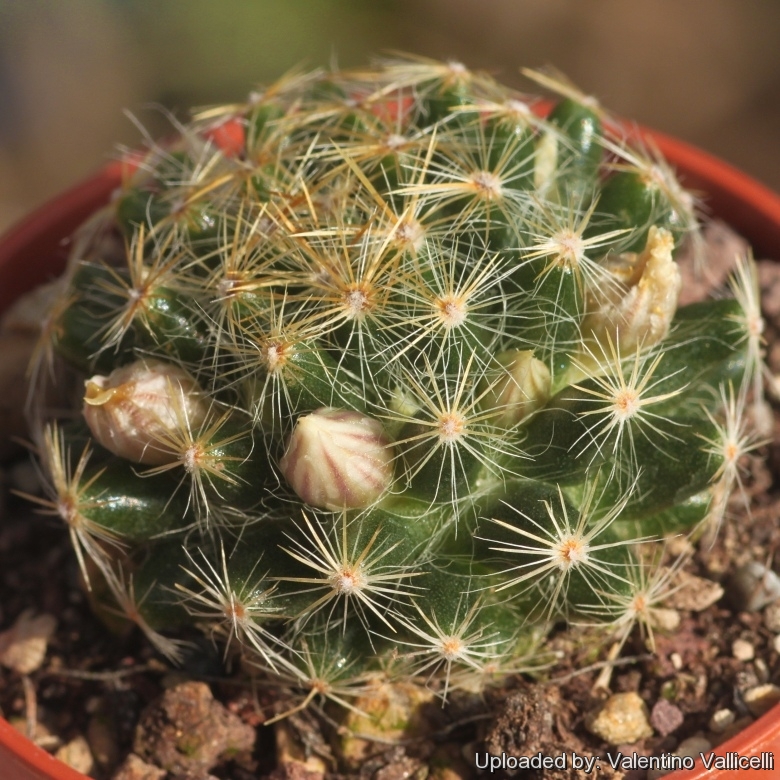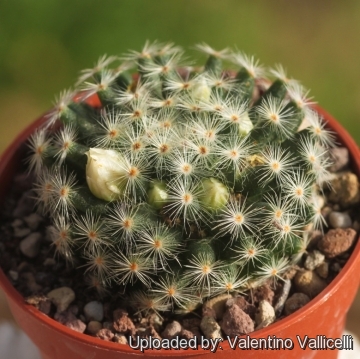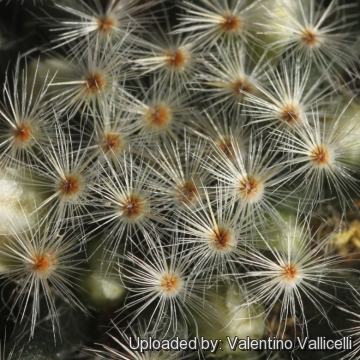Accepted Scientific Name: Mammillaria schiedeana subs. dumetorum (J.A.Purpus) D.R.Hunt
Mammillaria Postscripts 6: 7 (1997)

Mammillaria dumetorum (Mammillaria schiedeana subs. dumetorum) Photo by: Valentino Vallicelli
Origin and Habitat: Mammillaria schiedeanaSN|9339]]SN|2251]] is endemic to Mexico in the states of Guanajuato, Hidalgo, Querétaro, San Luis Potosí, and Tamaulipas while subsp. dumetorum is found only in East San Luis Potosi and in Queretaro.
Altitude: 1000-2250 metres above sea level.
Habitat and Ecology: Mammillaria schiedeanaSN|9015]]SN|2251]] ssp dumetorum is found in rather densely vegetated hill and gentle rocky slopes together with Turbinicarpus lauiSN|11701]]SN|11701]], Mammillaria candidaSN|2251]]SN|9015]], Ferocactus rafaelensisSN|1699]]SN|1699]], Mammillaria pilispinaSN|2251]]SN|9339]], Thelocactus fossulatusSN|10838]]SN|10838]], Agave xylonacanthaSN|568]]SN|208]], Agave lechuguillaSN|23013]]SN|23013]], Agave strictaSN|208]]SN|568]], and Dasylirion longissimumSN|21896]]SN|21896]].
Synonyms:
See all synonyms of Mammillaria schiedeana
Description: Mammillaria schiedeanaSN|2251]]SN|2251]] ssp dumetorum is a small clustering cactus, with short, closely interwoven, white plumose spines. It has less than 50 radial spines per areole and are stiffer than the fine spines of 'ssp. Schiedeana'. The flowers are near white.
Habit: It is solitary to densely caespitose. The size and shape of the stems is somewhat variable from small evenly flattened rounded tops merging together very low to the ground, to form even mounds with larger headed, separately standing stems.
Stem: Flattened globose, dark green, 55 mm high, 35-75 mm in diameter, somewhat soft in texture.
Roots: It has thick root.
Tubercles: Cylindrical, terete, tapered towards the tips, green, close together and without latex. Axil hairy, but no woolly.
Areoles: Round slightly woolly.
Radial spine: Always less than 50, mostly about 30, close to the stem, in 2 or 3 whorls, fine, needle-like to bristle-like. The 12 or14 outer marginal spines of the areoles are thin, somewhat thicker, awl-shaped, stiff, glassy white to yellowish, yellow at the base, the inner almost hair-like and thinner.
Central spine: Usually absent, occasionally 1, stiff, glassy white to yellowish, yellow at the base.
Flower: Whitish, about 1 cm long and in diameter.
Fruit: Red.
Seed: Black.
Subspecies, varieties, forms and cultivars of plants belonging to the Mammillaria schiedeana group
Bibliography: Major references and further lectures
1) Curt Backeberg “Cactus Lexicon” Sterling Publishing Company, Incorporated, 1978
2) Edward F. Anderson (2001) “ The Cactus Family”.
3) Hiroshi Hirao “Colour encyclopaedia of cacti” Japan 1979 (Japanese language and script)
4) Willy Cullmann, Erich Götz (Dozent Dr.), Gerhard Gröner “The encyclopedia of cacti” Portland, OR: Timber Press, 1986
5) David Hunt, Nigel Taylor “The New Cactus Lexicon” DH Books, 2006
6) Fitz Maurice, W.A. & Fitz Maurice, B 2013. Mammillaria schiedeana. In: IUCN 2013. "IUCN Red List of Threatened Species." Version 2013.2. <www.iucnredlist.org>. Downloaded on 05 January 2014.
7) Nathaniel Lord Britton, Joseph Nelson Rose “Cactaceae: Descriptions and Illustrations of Plants of the Cactus Family” vol. 4 The Carnegie Institution of Washington, Washington 1923
8) Walther Haage "Cacti and succulents: a practical handbook" Dutton, 1963
9) John Pilbeam “Mammillaria: the cactus file handbook” Cirio Publishing Services Ltd Dec/30,/1999
 Mammillaria dumetorum (Mammillaria schiedeana subs. dumetorum) Photo by: Valentino Vallicelli
Mammillaria dumetorum (Mammillaria schiedeana subs. dumetorum) Photo by: Valentino Vallicelli Mammillaria dumetorum (Mammillaria schiedeana subs. dumetorum) Photo by: Valentino Vallicelli
Mammillaria dumetorum (Mammillaria schiedeana subs. dumetorum) Photo by: Valentino VallicelliCultivation and Propagation: Mammillaria schiedeanaSN|2251]]SN|2251]] subs. dumetorum is a slow growing species of relatively easy culture, recommended for any collection. If grown correctly, it will reward the grower with generous displays flowers.
Growth rate: It grows slowly in its natural habitat, but in greenhouses it grows more quickly. In cultivation it cluster after several years forming small mounds.
Watering: It is noticeably sensitive to excess moisture, as the roots are prone to rot. Water regularly in summer, but do not overwater. Let the soil dry out between watering. Keep dry in winter.
Soil: Use pot with good drainage and a very porous potting media.
Fertilization: Feed with a high potassium fertilizer in summer.
Hardiness: It is quite frost resistant if kept dry, hardy as low as -5° C (some reports give it hardy to -5°C)
Sun Exposure: High levels of light are needed to flower and for good spine development. Can be sunburned if moved from shade/greenhouse into full sun too quickly. During the spring it may be able to take full sun until the heat arrives at the end of spring. In an area that has hot afternoon sun, it may be able to take full morning sun, but requires afternoon shade or afternoon light shade.
Repotting: Re-pot in the spring when its roots become cramped. Generally, it should be re-potted every other year, in order to provide fresh soil. After re-potting, do not water for a week or more. For best results, use a shallow pot, and only use the smallest diameter pot that will accommodate the plant.
Propagation: Direct sow after last frost (usually) or division, wait until the offsets that appear at the base of old clustered specimens are 1/3 the size of the parent and then detach and plant. (Cuttings root quickly)












